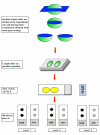Recent advances in the surgical care of breast cancer patients
- PMID: 20089167
- PMCID: PMC2828445
- DOI: 10.1186/1477-7819-8-5
Recent advances in the surgical care of breast cancer patients
Abstract
A tremendous improvement in every aspect of breast cancer management has occurred in the last two decades. Surgeons, once solely interested in the extipartion of the primary tumor, are now faced with the need to incorporate a great deal of information, and to manage increasingly complex tasks. As a comprehensive assessment of all aspects of breast cancer care is beyond the scope of the present paper, the current review will point out some of these innovations, evidence some controversies, and stress the need for the surgeon to specialize in the various aspects of treatment and to be integrated into the multidisciplinary breast unit team.
Figures

Similar articles
-
[Assessment of management practices for women with early-stage breast cancer].Presse Med. 2007 Dec;36(12 Pt 1):1712-20. doi: 10.1016/j.lpm.2007.03.046. Epub 2007 Aug 8. Presse Med. 2007. PMID: 17689916 French.
-
European guidelines for quality assurance in the surgical management of mammographically detected lesions. European Breast Cancer Working Group.Ann Chir Gynaecol. 1998;87(1):110-2. Ann Chir Gynaecol. 1998. PMID: 9598249
-
Surgical leadership and standardization of multidisciplinary breast cancer care: the evolution of the National Accreditation Program for Breast Centers.Surg Oncol Clin N Am. 2014 Jul;23(3):609-16. doi: 10.1016/j.soc.2014.03.005. Surg Oncol Clin N Am. 2014. PMID: 24882354 Review.
-
Inequalities in breast cancer care and outcome.Br J Cancer. 1997;76(5):634-8. doi: 10.1038/bjc.1997.437. Br J Cancer. 1997. PMID: 9303363 Free PMC article.
-
[Surgical treatment of breast cancer--2009].Orv Hetil. 2009 Dec 20;150(51):2291-6. doi: 10.1556/OH.2009.28762. Orv Hetil. 2009. PMID: 19995692 Review. Hungarian.
Cited by
-
Ductal carcinoma in situ: what can we learn from clinical trials?Int J Surg Oncol. 2012;2012:296829. doi: 10.1155/2012/296829. Epub 2012 May 9. Int J Surg Oncol. 2012. PMID: 22649720 Free PMC article.
-
Adipose-derived Mesenchymal Stem Cells (ASCs) may favour breast cancer recurrence via HGF/c-Met signaling.Oncotarget. 2014 Feb 15;5(3):613-33. doi: 10.18632/oncotarget.1359. Oncotarget. 2014. PMID: 24327602 Free PMC article.
-
Breast segmentectomy with rotation mammoplasty as an oncoplastic approach to extensive ductal carcinoma in situ.World J Surg Oncol. 2016 Mar 9;14:72. doi: 10.1186/s12957-016-0825-5. World J Surg Oncol. 2016. PMID: 26956623 Free PMC article.
-
100 Disruptive Publications in Breast Cancer Research.Asian Pac J Cancer Prev. 2021 Aug 1;22(8):2385-2389. doi: 10.31557/APJCP.2021.22.8.2385. Asian Pac J Cancer Prev. 2021. PMID: 34452550 Free PMC article.
-
The Applications of High-Intensity Focused Ultrasound (HIFU) Ablative Therapy in the Treatment of Primary Breast Cancer: A Systematic Review.Diagnostics (Basel). 2023 Aug 4;13(15):2595. doi: 10.3390/diagnostics13152595. Diagnostics (Basel). 2023. PMID: 37568958 Free PMC article. Review.
References
-
- Fisher B, Anderson S, Redmond CK, Woolmer N, Wickersham DL, Cronin WM. Reanalysis and results after 12 years of follow-up in a randomized clinical trial comparing total mastectomy with lumpectomy with or without irradiation in the treatment of breast cancer. N Engl J Med. 1995;333:1456–61. doi: 10.1056/NEJM199511303332203. - DOI - PubMed
Publication types
MeSH terms
LinkOut - more resources
Full Text Sources
Medical
Research Materials

